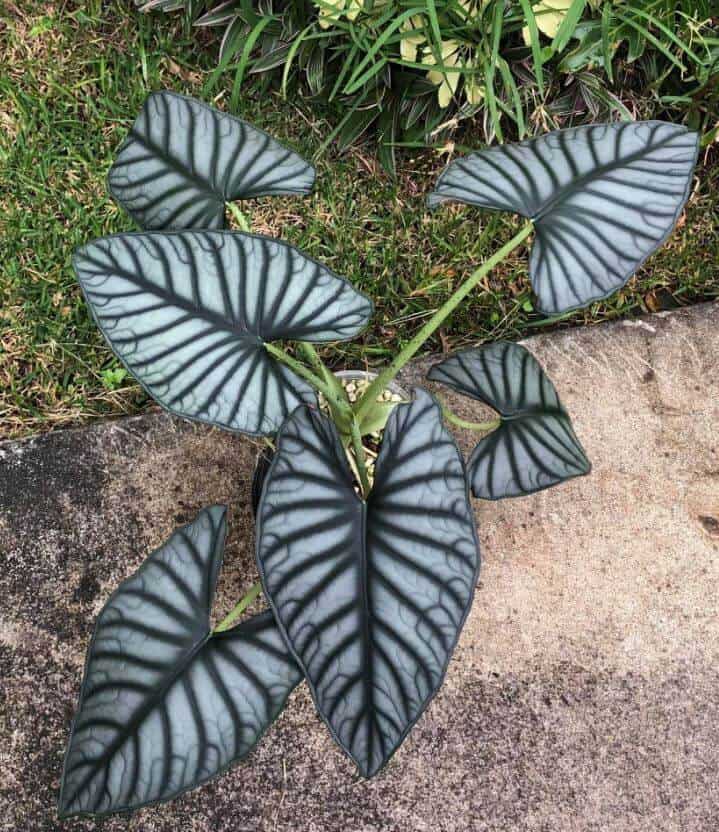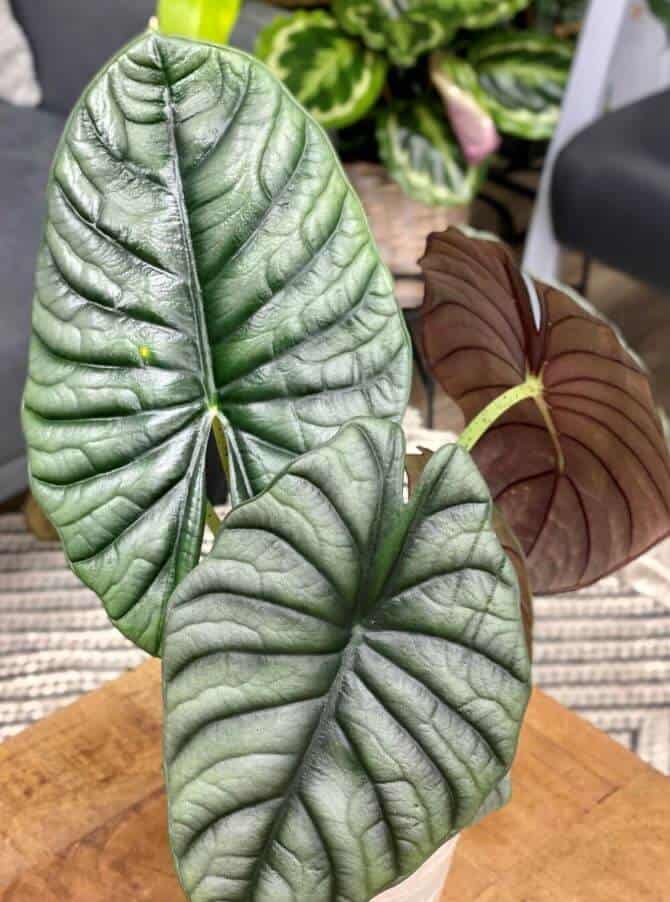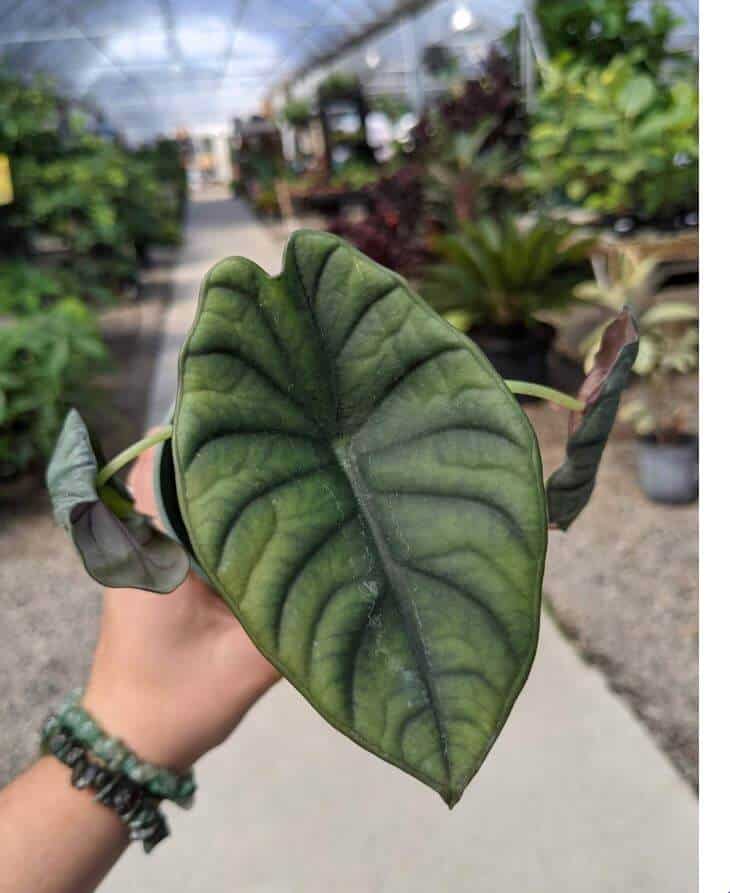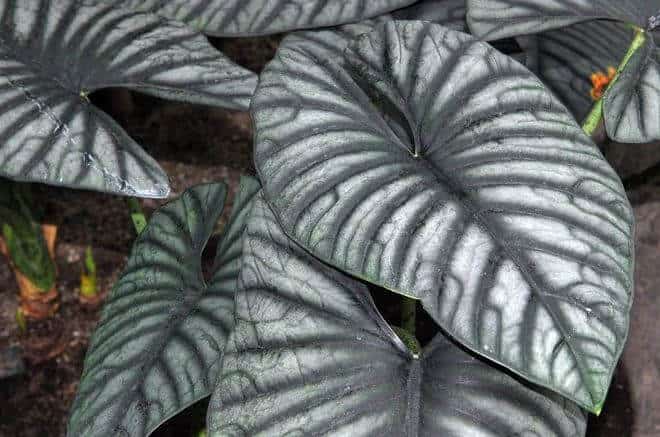Last Updated on September 3, 2023 by a Friendly Gardener
Alocasia plants are most commonly referred to as Elephant Ear plants or African Mask plants and many popular cultivars can be found in indoor gardens globally. One of the rarer varieties of this tender perennial is the Alocasia Nebula, an Australian native. This is a high-maintenance variety that requires a bit of experience; hence this is not the best choice for a beginner gardener.
The Alocasia nebula boasts highly attractive thick foliage that is a deep silvery green with beautiful veining. It brings an exotic appeal to indoor décor.
Alocasia Nebula Care

A true diva of the plant world, the Alocasia black nebula demands a proper environment and proper care to manifest all its beauty. It can grow rapidly when well cared for. You may see new foliage weekly during the growing season. When the Alocasia nebula reaches maturity, it can grow to heights of three to four feet.
Soil
The growing medium for an alocasia will play a significant role in the plant’s well-being. Root systems contain both rhizomes and tubers, so the soil mix is crucial to survival. Experts suggest mixing one part peat mix with one part perlite and one part quality potting soil. This guarantees necessary nutrients while at the same time keeping soil light, loose, and well-aerated. Your soil mix must be well-draining. Amend soil that feels heavy with additional perlite.
Water

Soil does need some water retention so that it is partially moist. The best method for achieving this is to water more often but give very small amounts of water. You may want to try watering with a spray bottle pointed toward the soil bed. Make sure the upper half of your growing medium is damp. When it dries, it’s time to water again.
Generally, an Alocasia must be watered several times weekly in warmer weather, and perhaps twice weekly in winter. Soil should not be allowed to become waterlogged or soggy. You can opt to use a moisture meter if you are unsure but take care not to damage rhizomes and tubers under the soil. Also, use collected rainwater or distilled water for these plants as they do not respond well to municipal tap water.
Light
The Alocasia nebula prefers generous bright indirect light. Never expose this plant to direct sunlight. The delicate foliage is prone to sunburn. Spots with partial shade are fine. If you have a low-light location, compensate with artificial light.
Humidity
These plants need high humidity. You need to place it in a steamy bathroom or get a space humidifier or humidifier dome for your plant. Common house humidity averages around 50%, but this is inadequate for this cultivar. Some people choose to cultivate alocasias in water as evaporation provides adequate humidity around the plant without interruption.
While you can try a pebble tray, it may not be enough to prevent crispy leaf edges and tips. Find a spot where humidity sits at 65% or higher for the best results.
Temperature

An Alocasia nebula prefers average to warm indoor temperatures measuring between 60° and 80°F. If this plant is exposed for any period to temps below 60° F, it will enter dormancy and leaf drop will result.
It is not tolerant of cold or frost. Should it be placed in a drafty location or exposed to extremely high temperatures, it will drop its leaves. Should you experience leaf drop with an Alocasia do not assume that it is dead or dying. The tubers beneath the soil will maintain life. In time with the proper care and conditions, new growth will appear.
Feeding
The Alocasia nebula needs feeding, as it will wilt without sufficient nutrition. However, it is also susceptible to root burning. To feed your alocasia use a diluted liquid fertilizer for houseplants. Make sure you dilute it to one-fourth its strength. Apply it after you have watered your plant.
Ideally, fertilizer should be given bi-weekly during the growing season. As the growing season winds to a close, growth slows, and the plant enters dormancy, reducing feeding to once monthly until the next growing season. Should your plant enter dormancy before winter for whatever reason, reduce feeding at once to a monthly application.
Repotting an Alocasia Nebula

This is a rhizomatous plant, so it likes to be slightly root-bound. If you are repotting, choose a plant that is just large enough to host the root ball. Repot annually with fresh soil mix without changing your pot. Use a new container if it is necessary for the plant’s health. Terracotta or clay pots with drainage holes are best as they help wick away excess moisture.
Alocasia Nebula Propagation

If you wish to propagate your plant, it should be done in the spring and summer during the growing season. Propagation is best accomplished by division and can be done so in either soil or water. During repotting is the best time to divide your alocasia. This plant grows in clump formations, so when you remove the plant from its pot, gently shake off any dirt and rinse off the root system.
Examine the root clumps and determine where you wish to divide them. The section you want for the new plant should have several leaves and roots. Separate this clump gently with sterilized scissors or a garden knife. Place the proper soil blend in a new container and moisten the soil. Make a hole and place the plant inside. Move soil gently around the plant and water it again with collected rainwater or distilled water.
Pests and Problems
The Alocasia nebula is susceptible to several diseases including:
- Bacterial Leaf spot
- Root rot
- Stem rot
- Xanthomonas
It is also susceptible to common houseplant pests such as aphids, mealybugs, and scales among others. The best defense is to keep your plant healthy. Use well-draining soil mixed with organic matter. The soil bed should be kept evenly moist but not overly wet. Place your plant in bright indirect light and away from potential drafts and environmental temperature changes. Also, keep the humidity levels high for a healthy, happy Alocasia.
Alocasia Nebula Toxicity
The Alocasia nebula is highly toxic and can cause irritation or allergic reactions on the skin or in the eyes. Keep this jewel away from small hands and fur babies.
Alocasia Nebula Varieties
The Alocasia nebula boasts several varieties as it has been hybridized to create new cultivars. Among these we find
- Alocasia nebula Balun
- Alocasia nebula Elaine
- Alocasia nebula Imperialis
Varieties should be cared for in the same manner as the Alocasia nebula.

